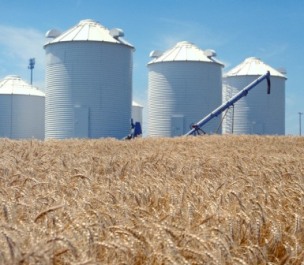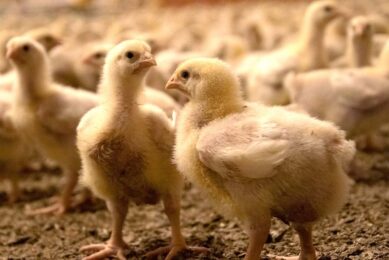Mycotoxins Part 2 – Current thoughts on global mycotoxicoses

Mycotoxins are not just mycotoxins. No less than around 500 mycotoxins are found in various regions around the world in all kinds of feed components, each of which has a different toxicity. Recognising and classifying them makes it easier to take proper measures.
By Dr H.V.L.N. Swamy, Alltech Canada
Mycotoxins are the secondary metabolites of moulds, which are ubiquitous in nature. Four genera of mycotoxin-producing moulds on a global scale include Aspergillus, Fusarium, Penicillium and Claviceps. The recent survey on Alternaria toxins from Argentina is certainly forcing us to include Alternaria mould into the above list. Depending on various factors, one or more of these moulds grow on crops while they are on the field as well as during storage.
There are close to 500 mycotoxins that have been identified to date, and undoubtedly there are many more to come. The immediate challenge that chemists around the world are facing is related to masked mycotoxins and the means and modes of analysing them so that their masked effects can be quantified. The objective, here, is to highlight the demonstrated effects of the key mycotoxins on poultry health and performance while referencing to their regional distribution. These include aflatoxins, ochratoxins, Type A trichothecene Fusarium mycotoxins, Type B trichothecene Fusarium mycotoxins, zearalenone, fumonisins, moniliformin, and ergot alkaloids. Classifying the mycotoxins to a specificregion has been curtailed in recent years due to the extended trading of grains and meals across the world, as well as appreciable changes in the global climatic conditions. Unexpected drought, rainfall and floods have added more mystery to the already complex issues of sampling and mycotoxin analysis. Nevertheless, the greater prevalence of a specific group of mycotoxins to a particular region can be generalised (Table 1).
Based on LD50 values (amount of mycotoxin required to kill 50% of test population), the order of severity for some of the mycotoxins is as follows: Ochratoxins > Diacetoxyscirpenol (DAS) > T-2 toxin > Moniliformin > Aflatoxins > HT-2 toxin > Neosolaniol > Deoxynivalenol (DON) (Table 2). Although aflatoxins are very well studied in poultry, ochratoxins, DAS and T-2 toxin are more toxic than aflatoxins.
Toxicity of some mycotoxins
The biggest challenge with mycotoxicosesis the non-specific nature of symptoms in poultry. This makes it very hard for the poultry producer to diagnose the problem and take appropriate actions. The symptoms of mycotoxicoses can also be similar to those arising as a result of poor management, nutrition and health. Hence it is quite common under commercial conditions to compare the mycotoxin results of poultry feed with the symptoms on the farm to confirm mycotoxicoses. Acute and chronic toxicities of some of the important mycotoxins in poultry are discussed here. The toxicity of mycotoxins generally depends on the dose and source of mycotoxins, and the duration of exposure.
1. Aflatoxins: Although 18 different aflatoxins have been identified, only aflatoxins B1, B2, G1 and G2 have been detected as natural contaminants of feeds and feedstuffs. There are discrepancies in the literature in terms of the minimum dose of aflatoxin that is required to cause toxicity in poultry. This can be attributed mainly to different sources of aflatoxins used in these studies. Most of the studies used either purified AFB1 or AFB1 from Aspergillus fungal culture but not naturally-contaminated feed. A broiler chicken study, however, has shown to reduce body weight at levels as low as 75 ppb aflatoxins. Reduced egg production and egg weight, and increased liver fat are the major signs of aflatoxicoses in laying hens, while poor hatchability and increased embryonic mortality were noticed in breeding hens. The greatest effect of aflatoxins on immunity is on the cell mediated immune response such as lymphocyte depletion, decreased delayed-type hypersensitivity, and modification of cytokine production. This can result in poor disease resistance and vaccine response. Aflatoxins can also lead to poor pigmentation in broiler chickens.
2. Ochratoxins: Although the ochratoxin group comprises 7 compounds, only ochratoxin A (OA) has been found as a natural contaminant of cereal grains. Kidneys are the major target organs for ochratoxins. Increased water consumption and manure moisture, swollen and pale kidneys, and secondary visceral gout are some of the specific symptoms of ochratoxicoses in poultry. Similar to aflatoxins they have been shown toreduce feed intake, lower egg production and weight, and negatively effect feed efficiency. Increased incidence of shell stains and meat spots have also been reported in commercial layers. OA impairs the ability of chickens to utilise dietary carotenoids for carcass pigmentation more severely than aflatoxins. As per the scientific literature, 0.5 ppm seems to be the minimum dose of OA to cause problems in poultry.
3. Type A trichothecene Fusaium mycotoxins: The toxicity of these mycotoxins in poultry has been recentlyreviewed by Meissonnier and co-workers. Their target organs primarily include the rapidly dividing cells lining the gastrointestinal tract, the skin, and lymphoid and erythroid system. Although they are more toxic than type B tricho-thecene mycotoxins, their occurrence is sporadic. They are often found at higher concentrations in Eastern Europe, and have been implicated in acute toxicity in poultry. The acute toxicity of type Atrichothecene mycotoxins is characterised by circumscribed proliferative yellow caseous plaques occurring at the margin of the beak, mucosa of the hard palate, angle of the mouth and the tongue. Classical symptoms of chronic toxicity include erosions and/or ulcerations in the oral cavity and esophagus. These symptoms were dose-dependent, and may serve as a diagnostic tool. Abnormal feathering in young chicks fed scripenol mycotoxins up to 3 weeks of age has also been reported. Their radiomimetic activity can lead to severenecrosis and haemorrhages in the gastro-intestinal tract thereby reducing nutrient absorption. They also reduce feed intake via altering brain neurochemistry.
Trichothecene A mycotoxins-induced immune suppression affects all the components of the immune system (inflammation, humoral and cell-mediated responses). Further studies on cytokine regulation with moderate doses of these mycotoxins may help to understand the different changes in immune cell functioning. In young chickens infected with Salmonella and Coccidia, T-2 toxin exposure can decrease their disease resistance. Furthermore, the consumption of T-2 toxin (0.75-1.25 mg/kg feed) can reduce the efficacy of anticoccidial drugs in young chicks infected with coccidial oocysts. As per scientific literature, approx. 0.5 ppm seems to be the minimum dose for these mycotoxins to cause problems in poultry.
4. Type B trichothecene Fusarium mycotoxins: The major mycotoxin belonging to this group is DON. Although DON is relatively less toxic to poultry, it is an important mycotoxin to be aware of due to not only its global presence at higher concentrations, but also due to its potential to occur along with others. Birds consuming grains contaminated with these mycotoxins, especially DON, do not exhibit severefeed refusal as compared to those exposed to Type A mycotoxins. As a result, the birds continue eating infected feed, resulting in poor feed utilisation and immune suppression.
There has been a great deal of research conducted on this group of mycotoxins in various classes of poultry via the feeding of contaminated grains. Some of the findings include mouth plaques, gizzard erosions, anaemia, decreased in vivo hepatic fractional protein synthesis, increased blood urea nitrogen and uric acid concentrations, decreased biliary IgA concentrations, reduced % B cells and CD4+ T lymphocytes in blood, reduced delayed-type hypersensitivity, altered brain neurochemistry, decreased apparent surface area of intestinal villi, and altered cytokine expression. In breeders, increased incidence of in-shell deaths, unabsorbed yolk sac, and early embryonic mortality have been reported. The minimum dose to cause problems in poultry seems to be approx. 2 ppm as per the latest research from the University of Guelph.
5. Fumonisins: So far, six different fumonisins (A1, A2, B1, B2, B3 and B4) have been isolated and their mechanism of action appears to be a disruption of synthesis of sphingolipids. They have low toxicity for poultry, but because they can occur at very high concentrations in poultry feed (mainly through corn), along with other mycotoxins, caution is advised. Feeding fumonisin B1 to broiler chickens at 50 ppm reduced weight gain, ND antibody titers, and increased relative heart weight. Histological changes included vacuolar degeneration and cell proliferation of bile ducts in the liver, and hydropic degeneration in renal tubules in the kidneys. The biggest challenge from fumonisins to poultry seems to be on their immune system. However, more research is needed in this direction.
6. Moniliformin: This is highly toxic to chickens but its mode of action is still unclear. Acute death without gross lesions has been observed in broilers fed diets containing moniliformin and fumonisins. The minimum dietary level of moniliformin causing mortality in growing broilers appears to be in the range of 16-27 ppm. It appears that moniliformin is more toxic than fumonisin B1, and they have additive interaction.
7. Ergot alkaloids: Ergotism is the disease caused by the ingestion of alkaloids contained in the sclerotia of Claviceps species. There are several ergot alkaloids detected in grains (sorghum, wheat, barley, oat and rye) used for poultry feed. These are pharmacologically active compounds. Safe dietary levels of ergot for chickens appear to range between 0.3- 0.8% by weight. Because of the wide biological variation in both the quantity and quality of the alkaloids present in ergot sclerotia, it is very difficult to establish safe levels. Apart from the performance losses, vesicular dermatitis of the comb and wattles, necrotic lesions in the feet, toe, beak, and nails are just some of the specific symptoms of ergotism in poultry.
Mycotoxin interactions
Mycotoxins seldom occur in isolation in poultry feeds. Mycotoxins often occur together, and the aforementioned mycotoxins are by no means a complete list. The prominent mycotoxins missingfrom the discussion, as it relates to poultry, are citrinin, cyclopiazonic acid, fusarochromanone, fusaric acid, zearalenone and several other unidentified myco-toxins. This co-occurrence makes the individual mycotoxin tolerance dose irrelevant (safe levels) and therefore the mere presence of multiple mycotoxins in poultry feed should be considered as a risk. Mycotoxin interactions within the body of birds are very proven, and these are mainly additive in nature, but can be synergistic and antagonistic as well. It is important to note that these interactions vary for different parameters such as body weight, serum chemistry etc.
To conclude, although it is difficult to generalise the global geographical distribution of mycotoxins, an attempt has been made to refer them to a region based on the survey work and weather conditions. This should be considered with caution as the increased global trading can result in unexpected mycotoxins in poultry feed. The complete review of the toxicity of all the known mycotoxins is beyond the capacity of this article, but the reference to the most common ones is made with some key aspects to be kept in mind.
* References available on request
Join 31,000+ subscribers
Subscribe to our newsletter to stay updated about all the need-to-know content in the poultry sector, three times a week. Beheer
Beheer








 WP Admin
WP Admin  Bewerk bericht
Bewerk bericht